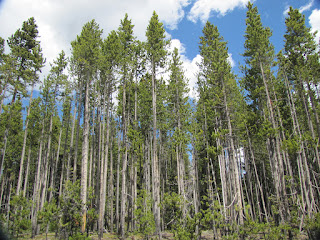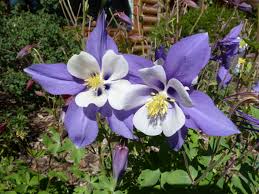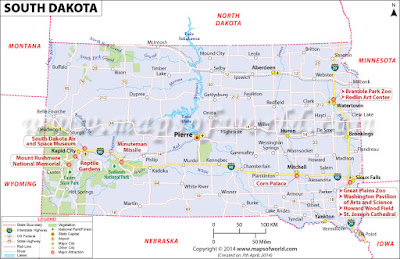Day 48 (D-15) Another day of Yellowstone information (BBC too, if you like)
Life in Yellowstone:
(With a BBC 6-minute English as an option.)
1. There are 67 species of mammals (elk, moose, mule deer, white-tailed deer, pronghorn, bighorn sheep, cougar, to name a few). There are 2 species of bears, the black bear and the grizzly bear. There are two threatened species, the Canadian lynx and the grizzly bear. The Yellowstone Park bison is the largest public herd of American bison in the United States.
2. There are 285 species of birds, 16 species of fish, 5 species of amphibians and 6 species of reptiles.
3.Starting in 1914, in an effort to protect the elk populations, the U.S. Congress gave money to be used for the purposes of "destroying wolves, prairie dogs and other animals injurious to agriculture and animal husbandry" on public lands. After the wolves were extirpated from Yellowstone, the coyote became the park's top canine predator. However, the coyote is not able to bring down large animals, and the result of this lack of a top predator on these populations created an increase in lame and sick megafauna. In the 1990s northwestern wolves imported from Canada were reintroduced into the park. The recovery of populations throughout the states of Wyoming, Montana and Idaho has been so successful that on February 27, 2008, the Northern Rocky Mountain wolf population was removed from the endangered species list.
https://www.youtube.com/watch?v=am-3Ju1fNoE to see a few animals, just 2 minutes and 14 seconds. Wild Yellowstone: Fiercest Five
4. How about plant life? There are over 1,700 species of trees and other vascular plants native to the park. Forests cover roughly 80% of the park and lodgepole pine comprises nearly all of that canopy.
And Yellowstone is a wildflower garden.
If you are curious, here is something about the smaller inhabitants of Yellowstone:
In Yellowstone's hot waters, bacteria form mats of bizarre shapes consisting of trillions of individuals. These bacteria are some of the most primitive life forms on earth. If you like, take a look at BBC 6-minute English. You can listen and you can read. VERY INTERESTING, and just 6 minutes.
http://www.bbc.co.uk/learningenglish/english/features/6-minute-english/ep-170119
My best,
Jane
PS Less is more.... but sometimes more is good! Isn't it?
___________________________________________
-- threatened = menacé
-- animal husbandry = élevage
-- extirpated = destroyed completely, wiped out (phrasal verb)
-- lack = absence (manque)
(With a BBC 6-minute English as an option.)
1. There are 67 species of mammals (elk, moose, mule deer, white-tailed deer, pronghorn, bighorn sheep, cougar, to name a few). There are 2 species of bears, the black bear and the grizzly bear. There are two threatened species, the Canadian lynx and the grizzly bear. The Yellowstone Park bison is the largest public herd of American bison in the United States.
2. There are 285 species of birds, 16 species of fish, 5 species of amphibians and 6 species of reptiles.
3.Starting in 1914, in an effort to protect the elk populations, the U.S. Congress gave money to be used for the purposes of "destroying wolves, prairie dogs and other animals injurious to agriculture and animal husbandry" on public lands. After the wolves were extirpated from Yellowstone, the coyote became the park's top canine predator. However, the coyote is not able to bring down large animals, and the result of this lack of a top predator on these populations created an increase in lame and sick megafauna. In the 1990s northwestern wolves imported from Canada were reintroduced into the park. The recovery of populations throughout the states of Wyoming, Montana and Idaho has been so successful that on February 27, 2008, the Northern Rocky Mountain wolf population was removed from the endangered species list.
https://www.youtube.com/watch?v=am-3Ju1fNoE to see a few animals, just 2 minutes and 14 seconds. Wild Yellowstone: Fiercest Five
4. How about plant life? There are over 1,700 species of trees and other vascular plants native to the park. Forests cover roughly 80% of the park and lodgepole pine comprises nearly all of that canopy.
 |
| Lodgepole pine, grow up to 75 feet tall (over 20 meters) |
If you are curious, here is something about the smaller inhabitants of Yellowstone:
In Yellowstone's hot waters, bacteria form mats of bizarre shapes consisting of trillions of individuals. These bacteria are some of the most primitive life forms on earth. If you like, take a look at BBC 6-minute English. You can listen and you can read. VERY INTERESTING, and just 6 minutes.
http://www.bbc.co.uk/learningenglish/english/features/6-minute-english/ep-170119
My best,
Jane
PS Less is more.... but sometimes more is good! Isn't it?
___________________________________________
-- threatened = menacé
-- animal husbandry = élevage
-- extirpated = destroyed completely, wiped out (phrasal verb)
-- lack = absence (manque)






Comments
Post a Comment